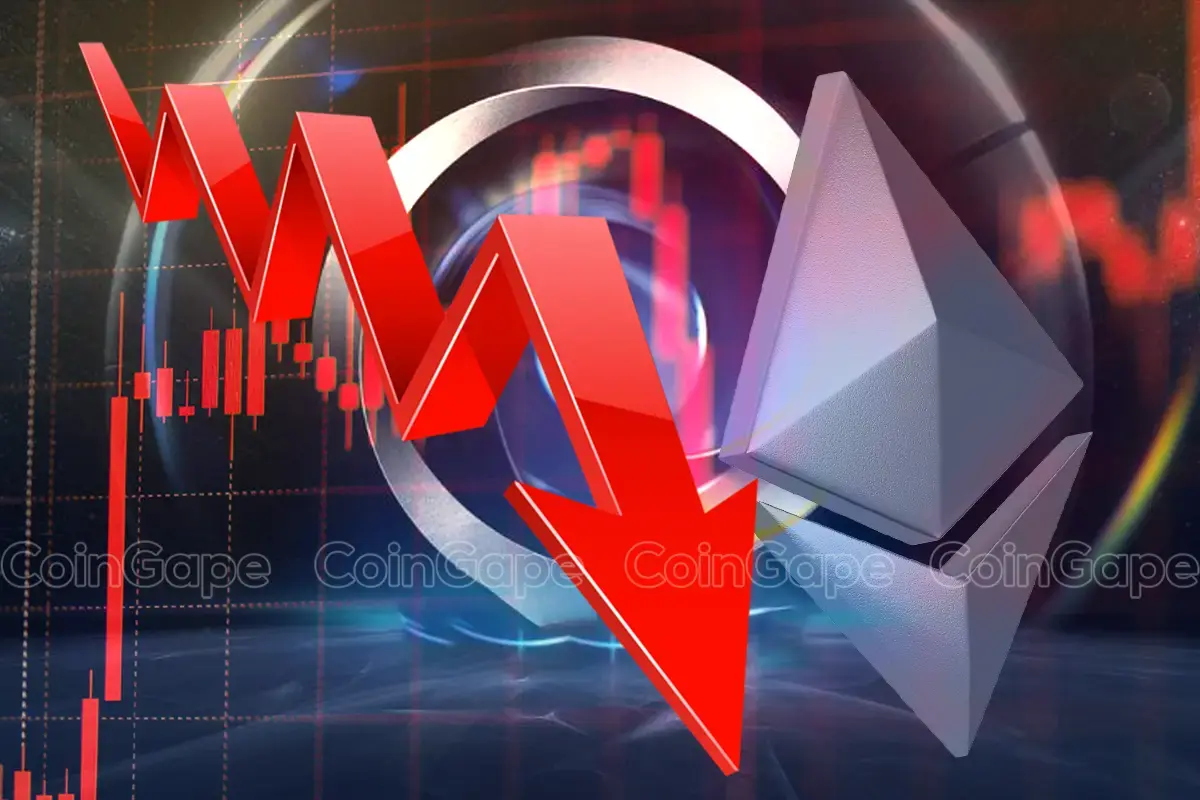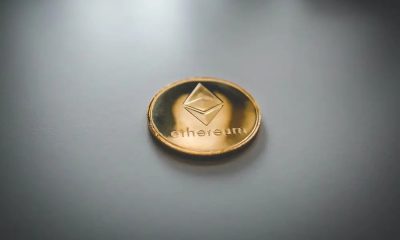Market
Ethereum Futures Open Interest Soars as $4,000 Target Looms

Ethereum’s (ETH) futures open interest has climbed to an all-time high of $16 billion amid the recent rally in the general cryptocurrency market.
This surge comes as the leading altcoin attempts to reclaim the $4,000 price level and rally toward its all-time high of $4,891, which it recorded three years ago.
Ethereum Futures Traders Put in More Buy Orders
As of this writing, ETH’s futures open interest was $16 billion. Its recent uptrend began on May 19 and has since increased 45%.
ETH’s futures open interest measures the total number of the coin’s futures contracts that have yet to be settled or closed. When it rises in this manner, it indicates an increase in market participants entering new positions.
Assessed on a year-to-date, ETH’s open interest has grown by 69%.

In addition, the rise in ETH’s futures open interest is accompanied by a positive funding rate. As of this writing, ETH’s funding rate was 0.014%.
The funding rate refers to the periodic payment made between traders in an asset’s futures market to ensure its contract price stays close to the spot price.
When the funding rate is positive, traders who hold long positions pay those with short positions. This usually occurs when the futures price is higher than the spot price. Indicating a higher demand for buying than selling.
Read more: 9 Best Places To Stake Ethereum in 2024

The combined reading of ETH’s rising open interest and positive funding rate suggests significant bullish activity in the coin’s futures market. It means that the number of market participants opening new positions and holding the altcoin in the expectation of a rally is rising.
ETH Price Prediction: The Yays Have It
Confirming the ongoing bullish trend, ETH’s Relative Strength Index (RSI) was in an uptrend at press time. With a value of 71.21, the momentum indicator signaled that market participants prefer to accumulate more ETH rather than sell their coins.
Further, the coin’s Chaikin Money (CMF), which tracks the flow of liquidity into and out of ETH’s market, rested above its center zero line at 0.22.
A CMF above zero indicates market strength, suggesting high capital inflow.

If the inflow of “new money” into the ETH market continues to rise, the coin may leave the $3790 level behind it to trade at $3838.
Read More: Ethereum (ETH) Price Prediction 2024/2025/2030
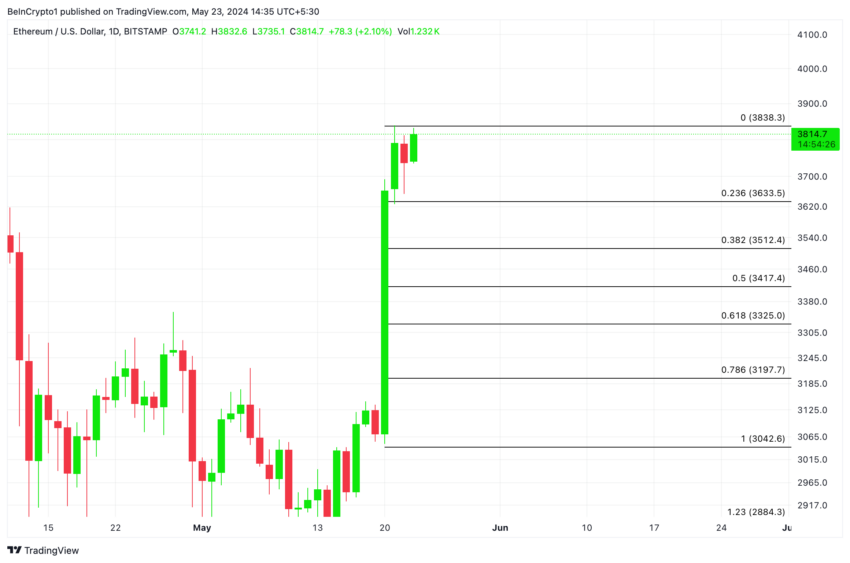
However, if profit-taking activity ensues and the bears re-emerge, ETH’s price might drop to $3633.
Disclaimer
In line with the Trust Project guidelines, this price analysis article is for informational purposes only and should not be considered financial or investment advice. BeInCrypto is committed to accurate, unbiased reporting, but market conditions are subject to change without notice. Always conduct your own research and consult with a professional before making any financial decisions. Please note that our Terms and Conditions, Privacy Policy, and Disclaimers have been updated.
Market
Crypto Derivatives Get a Boost from US CFTC
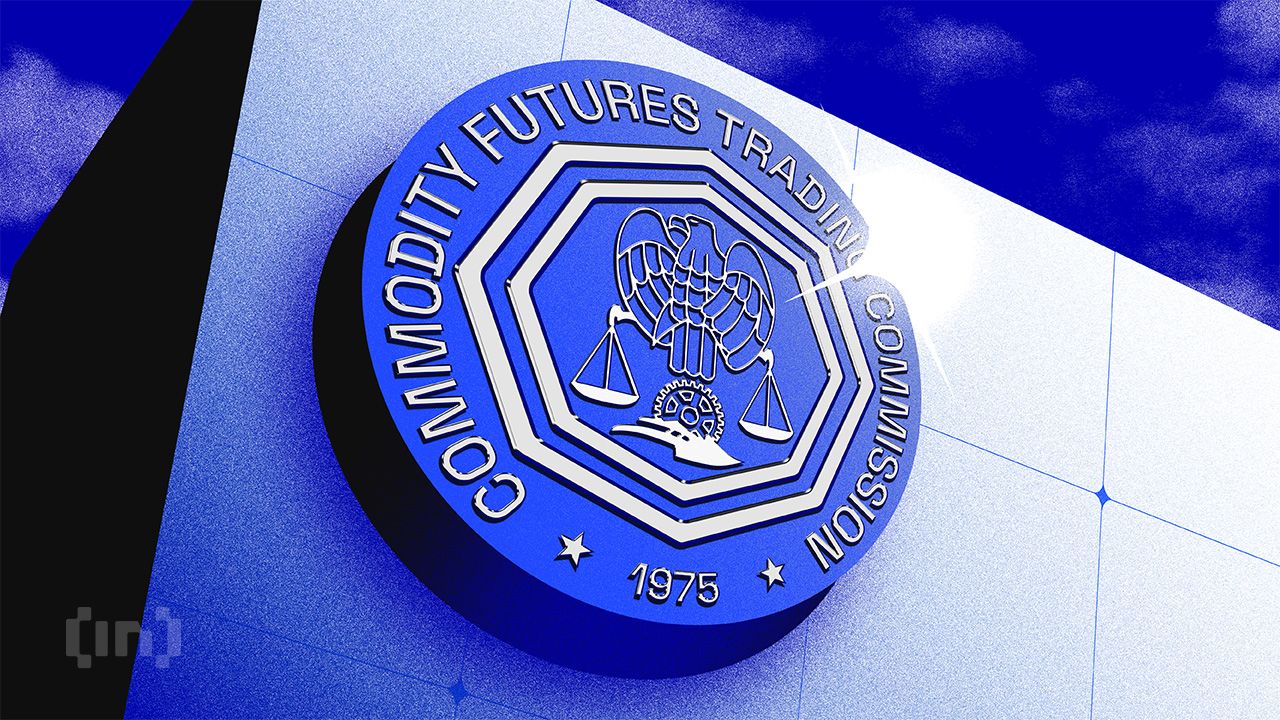
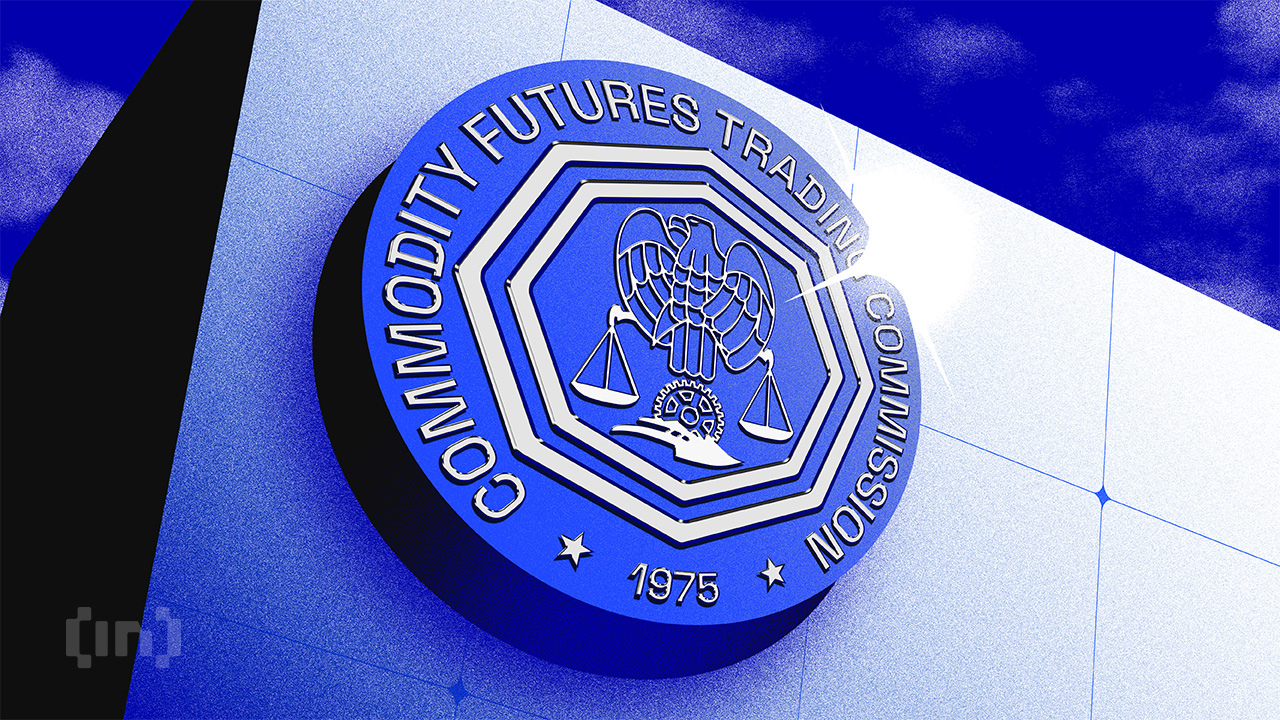
The US Commodities Futures Trading Commission (CFTC) scrapped a key directive that had previously signaled increased scrutiny for digital asset derivatives.
This decision indicates a friendlier regulatory climate for digital assets in the US, given the Trump administration’s pro-crypto stance.
CFTC Loosens Oversight for Crypto Derivatives
The CFTC withdrew Staff Advisory No. 23-07 and No. 18-14 by its Division of Clearing and Risk (DCR).
The former, issued in May 2023, focused on the risks of clearing digital assets. Meanwhile, the latter targeted virtual currency derivatives listings.
Upon establishment, both directives hinted at the singling out of crypto products for tougher oversight.
However, both have now been deemed unnecessary, effective immediately, amid the commodities’ regulator’s push toward regulatory consistency.
The decision indicates a shift to treating digital asset derivatives like those on Ethereum (ETH) as traditional finance (TradFi) products.
“As stated in today’s withdrawal letter, DCR determined to withdraw the advisory to ensure that it does not suggest that its regulatory treatment of digital asset derivatives will vary from its treatment of other products,” the CFTC explained.
This move will eliminate the perceived distinctions between digital asset derivatives and TradFi instruments.
It also paves the way for enhanced market participation, which will facilitate broader involvement from financial institutions in the digital asset derivatives market. This could lead to increased liquidity and market maturity.
Nevertheless, the advisory warned derivatives clearing organizations (DCOs) to prepare for risk assessments specific to digital products’ unique characteristics.
Therefore, while it reflects the CFTC’s commitment to promoting innovation, it also suggests the intention to maintain strong financial oversight.
Meanwhile, this decision comes only weeks after the Office of the Comptroller of the Currency (OCC) allowed US banks to offer crypto and stablecoin services without prior approval.
However, the OCC had articulated that despite lifting the approval requirement, banks must maintain strong risk management controls akin to those required for traditional banking operations.
“The OCC expects banks to have the same strong risk management controls in place to support novel bank activities as they do for traditional ones,” said Rodney E. Hood, the acting Comptroller of the Currency.
Therefore, the CFTC’s move to eliminate regulatory bias for crypto derivatives marks a major divide in US policy. On the one hand, the CFTC seeks to scrap the distinction between crypto derivatives and TradFi instruments.
On the other hand, the FDIC (Federal Deposit Insurance Corporation) and OCC want banks to maintain risk management controls similar to those required for traditional banking operations despite providing crypto and stablecoin services.
Notwithstanding, these efforts mirror a growing trend among US financial regulators to lower barriers and foster responsible innovation in the crypto industry.
Disclaimer
In adherence to the Trust Project guidelines, BeInCrypto is committed to unbiased, transparent reporting. This news article aims to provide accurate, timely information. However, readers are advised to verify facts independently and consult with a professional before making any decisions based on this content. Please note that our Terms and Conditions, Privacy Policy, and Disclaimers have been updated.
Market
XRP Falls 12% in a Week as Network Activity Declines

XRP is under heavy selling pressure, down more than 5% in the last 24 hours and over 12% in the past seven days. The recent downturn has been accompanied by increasingly bearish technical indicators, including a sharp spike in trend strength and a collapse in on-chain activity.
With price momentum weakening and user engagement dropping, concerns are mounting over XRP’s ability to hold key support levels. Unless sentiment shifts quickly, the path of least resistance appears to remain to the downside.
DMI Chart Shows The Current Downtrend Is Very Strong
XRP’s Directional Movement Index (DMI) is currently flashing strong bearish signals, with the Average Directional Index (ADX) surging to 47.14 from 25.43 just a day ago.
The ADX measures the strength of a trend, regardless of its direction, and values above 25 generally indicate that a trend is gaining momentum.
A reading above 40—like XRP’s current level—suggests a very strong trend is in play. Given that XRP is currently in a downtrend, this rising ADX points to intensifying bearish momentum and a market leaning heavily toward further declines.

Digging deeper into the DMI components, the +DI, which tracks upward price pressure, has dropped sharply from 20.13 to 5.76. Meanwhile, the -DI, which tracks downward price pressure, has surged from 8.97 to 33.77.
This stark divergence reinforces the bearish trend, indicating that sellers are aggressively taking control while buyer strength fades.
With ADX confirming the strength of this move and directional indicators tilting heavily to the downside, XRP’s price could remain under pressure in the short term unless a significant reversal in sentiment occurs.
XRP Active Addresses Are Heavily Down
XRP’s 7-day active addresses have seen a sharp decline over the past week, following a recent surge to new all-time highs. On March 19, the metric peaked at 1.22 million, signaling strong network activity and user engagement.
However, since then, it has plummeted to just 331,000—a drop of over 70%. This sudden fall suggests that interest in transacting on the XRP has cooled off significantly in a short span of time.
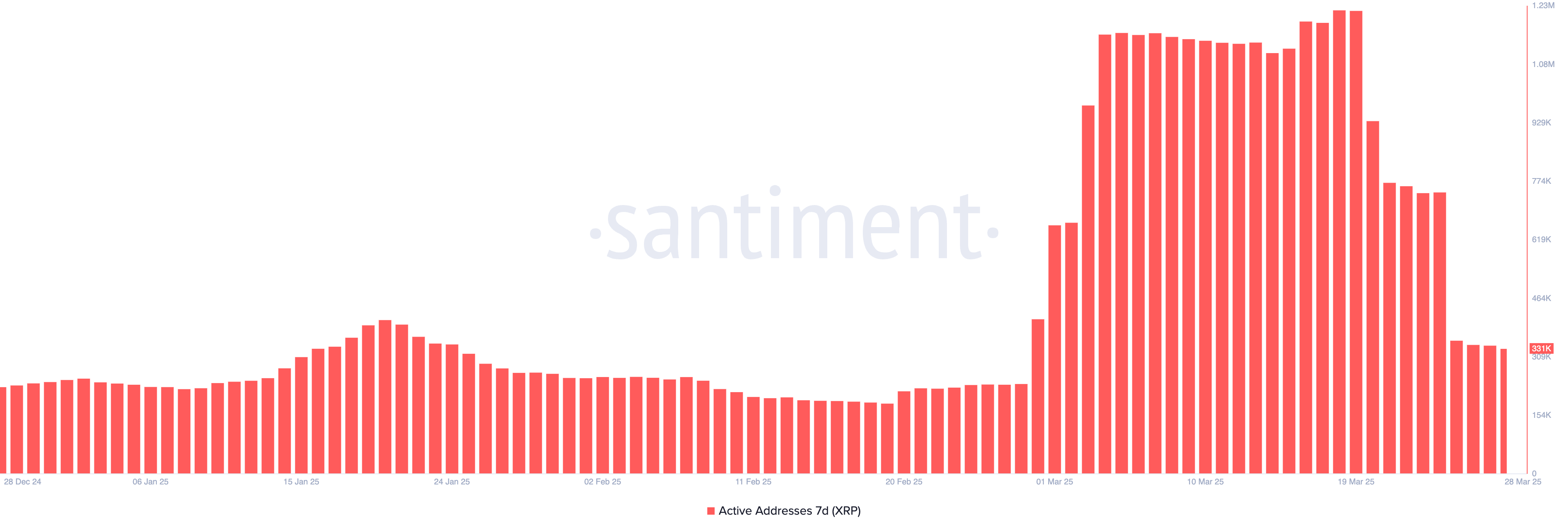
Tracking active addresses is a key way to gauge on-chain activity and overall network health. A rising number of active addresses typically reflects growing user participation, increased demand, and potential investor interest—factors that can support price strength.
Conversely, a sharp decline like the one XRP is currently experiencing can point to weakening momentum and fading interest, which could put additional pressure on price.
Unless user activity begins to rebound, this drop in network engagement may continue to weigh on XRP’s short-term outlook.
XRP Could Drop Below $2 Soon
XRP’s Exponential Moving Average (EMA) lines are currently signaling a strong downtrend, with the short-term EMAs positioned below the longer-term ones—a classic bearish alignment.
This setup indicates that recent price momentum is weaker than the longer-term average, often seen during sustained corrections. If this downtrend continues, XRP could retest the support level at $1.90.
A break below that could open the door to a deeper drop toward $1.77 in April.
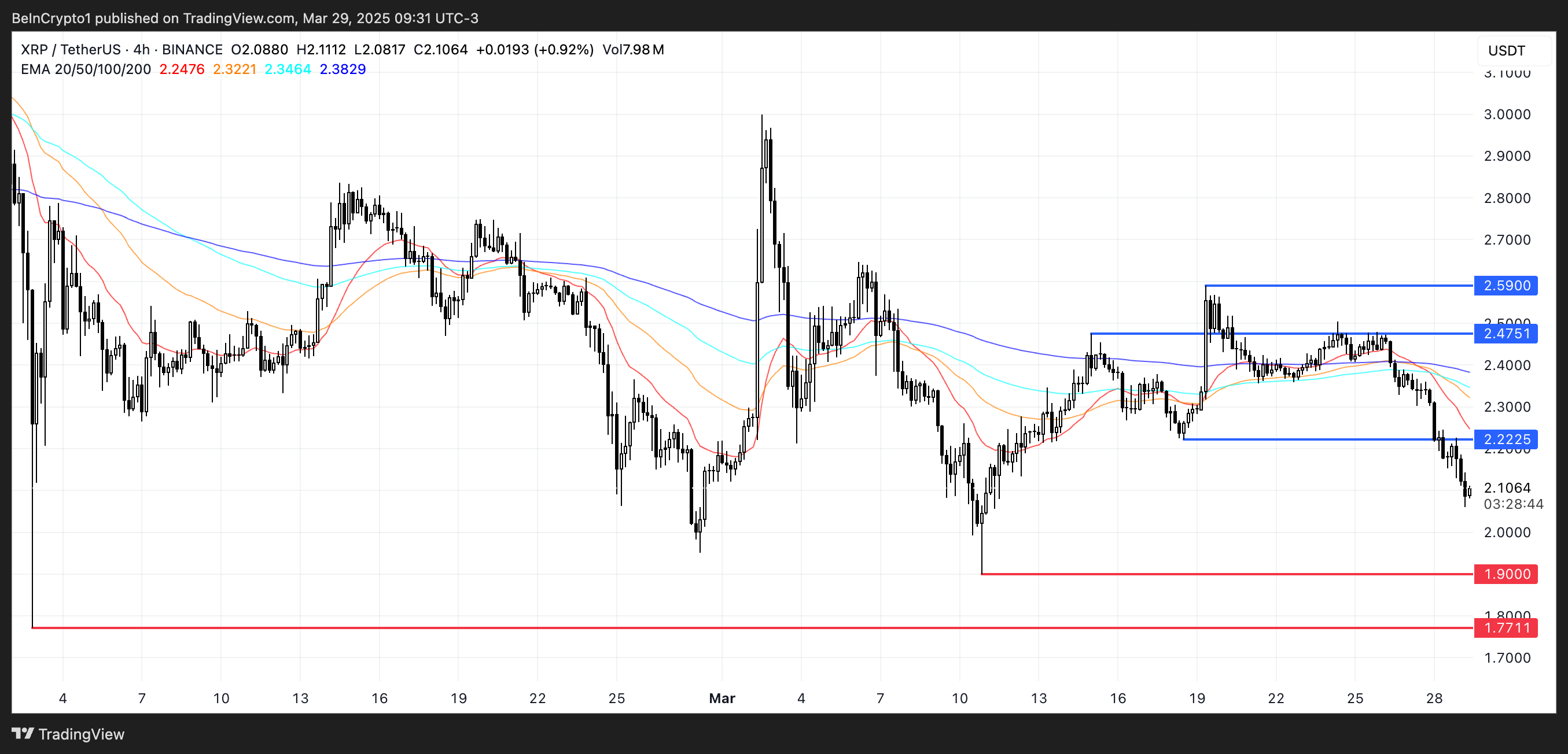
However, if market sentiment shifts and XRP price manages to reverse course, the first key level to watch is the resistance at $2.22.
A successful breakout above this point could trigger renewed bullish momentum, potentially driving the price up to $2.47.
If that level also gets breached, XRP could push further to test the $2.59 mark.
Disclaimer
In line with the Trust Project guidelines, this price analysis article is for informational purposes only and should not be considered financial or investment advice. BeInCrypto is committed to accurate, unbiased reporting, but market conditions are subject to change without notice. Always conduct your own research and consult with a professional before making any financial decisions. Please note that our Terms and Conditions, Privacy Policy, and Disclaimers have been updated.
Market
ONDO Whales Retreat as Price Risks Dropping Below $0.70

ONDO is facing notable downside pressure. It has been down over 5% in the last 24 hours and corrected more than 19% over the past 30 days. With its market cap now sitting around $2.5 billion, the coin is way below competitors like Chainlink and Mantra in terms of market cap.
Recent technical indicators and whale behavior suggest that the current weakness may not be over, despite a slight recovery in momentum.
ONDO RSI Is Recovering From Oversold Levels
ONDO’s Relative Strength Index (RSI) is currently sitting at 34 after rebounding slightly from an earlier dip to 27.5. Just two days ago, the RSI was at 54.39, indicating how quickly momentum has shifted.
The RSI is a momentum oscillator that measures the speed and magnitude of recent price changes. It ranges from 0 to 100.
Readings below 30 are typically considered oversold, suggesting the asset may be undervalued and due for a bounce, while readings above 70 are viewed as overbought, indicating potential for a pullback.

With ONDO’s RSI now at 34, it has technically exited oversold territory but remains near the lower end of the scale. This suggests that while the sharpest selling pressure may have eased, the market is still fragile ,and sentiment remains cautious.
If the RSI continues to recover and climbs above 40 or 50, it could signal a shift toward more bullish momentum.
However, if selling resumes and RSI falls back below 30, it would indicate renewed downside risk and potential for further price declines.
Whales Recently Stopped Their Accumulation
The number of ONDO whales—addresses holding between 1 million and 10 million ONDO—fluctuated in late March, initially increasing from 188 to 195 between March 22 and March 26 before declining to 191 in recent days.
This whale activity pattern is significant as these large holders often influence market sentiment and price movements, with their accumulation or distribution phases potentially foreshadowing broader market trends.
Tracking whale addresses provides valuable insights into how influential investors are positioning themselves, which can help predict potential price action.
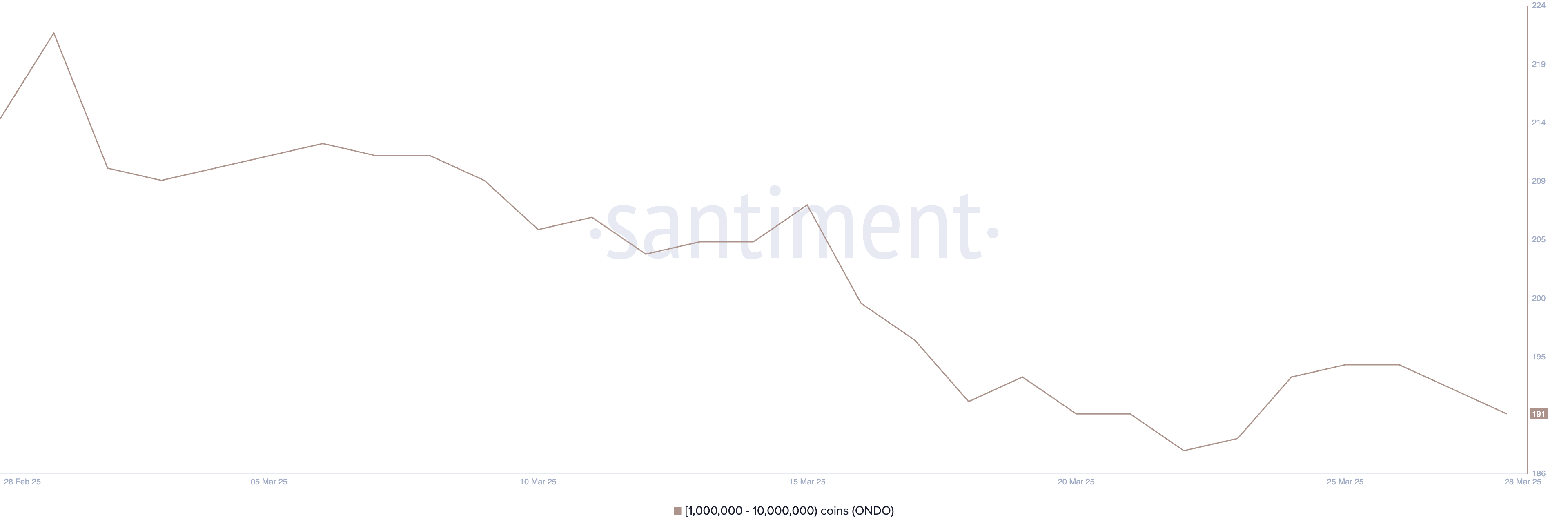
The failure of Whale addresses to maintain the breakout above 195 and the subsequent return to 191 could signal bearish sentiment among larger investors.
This retreat might indicate that whales are taking profits or reducing exposure, which could create downward price pressure on ONDO in the short term.
When large holders begin to reduce their positions after a period of accumulation, it often precedes price corrections, suggesting that ONDO may experience resistance in maintaining upward momentum until whale confidence returns and accumulation resumes.
Will ONDO Fall Below $0.70 For The First Time Since November?
ONDO’s Exponential Moving Average (EMA) lines are currently aligned in a bearish formation, suggesting the ongoing downtrend may persist. If this weakness continues, ONDO could drop to test the key support level at $0.73.
A break below that would be significant, potentially sending the price under $0.70 for the first time since November 2024.
The token has been struggling to keep pace with other Real World Asset (RWA) coins like Mantra, and this underperformance adds further pressure to ONDO’s short-term outlook.
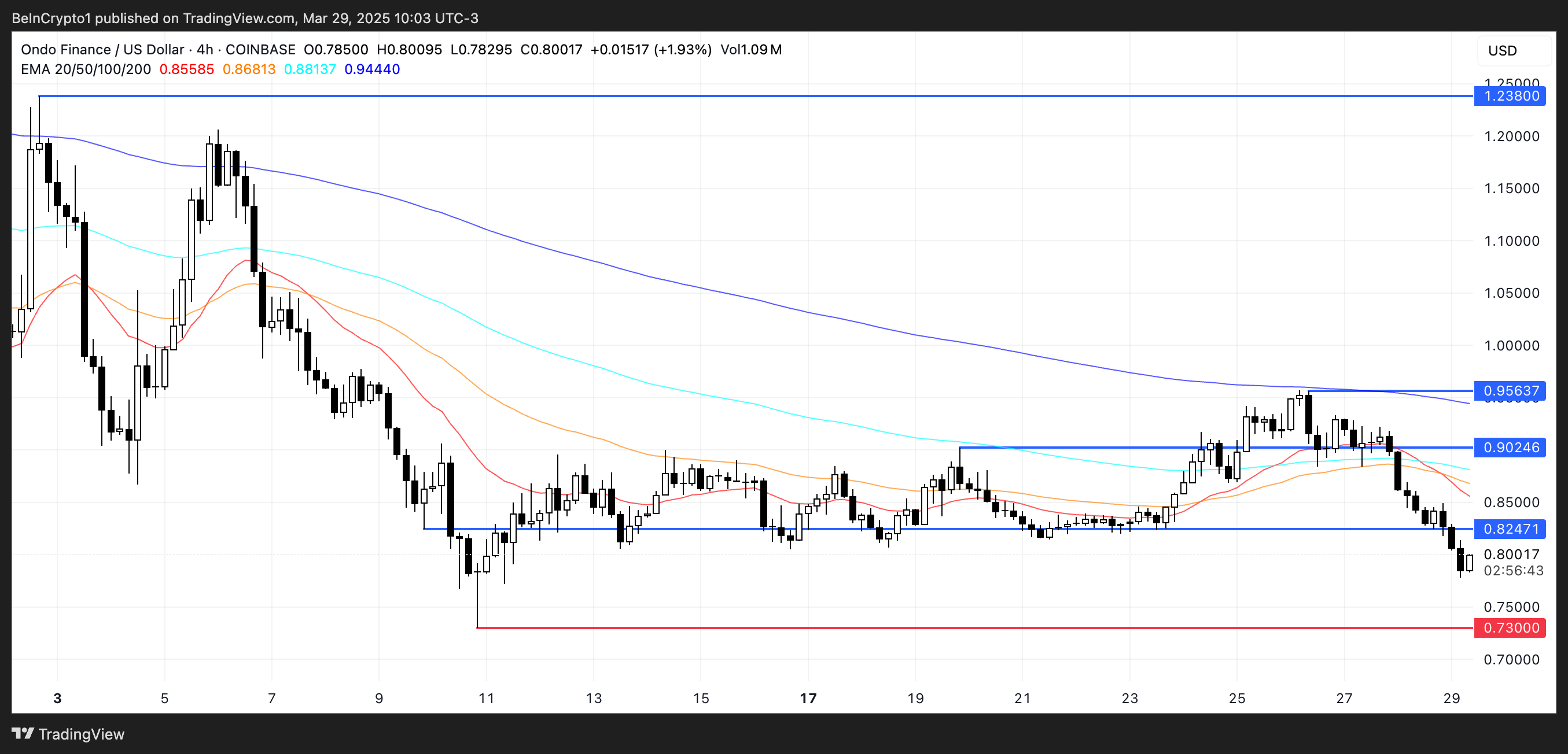
However, if sentiment shifts and ONDO manages to reverse its trend, the first key level to watch is the resistance at $0.82.
A breakout above this level could trigger a broader recovery, with price targets at $0.90 and $0.95.
If the RWA sector as a whole regains momentum, ONDO could even rise above the $1 mark and aim for the next major resistance at $1.23.
Disclaimer
In line with the Trust Project guidelines, this price analysis article is for informational purposes only and should not be considered financial or investment advice. BeInCrypto is committed to accurate, unbiased reporting, but market conditions are subject to change without notice. Always conduct your own research and consult with a professional before making any financial decisions. Please note that our Terms and Conditions, Privacy Policy, and Disclaimers have been updated.
-
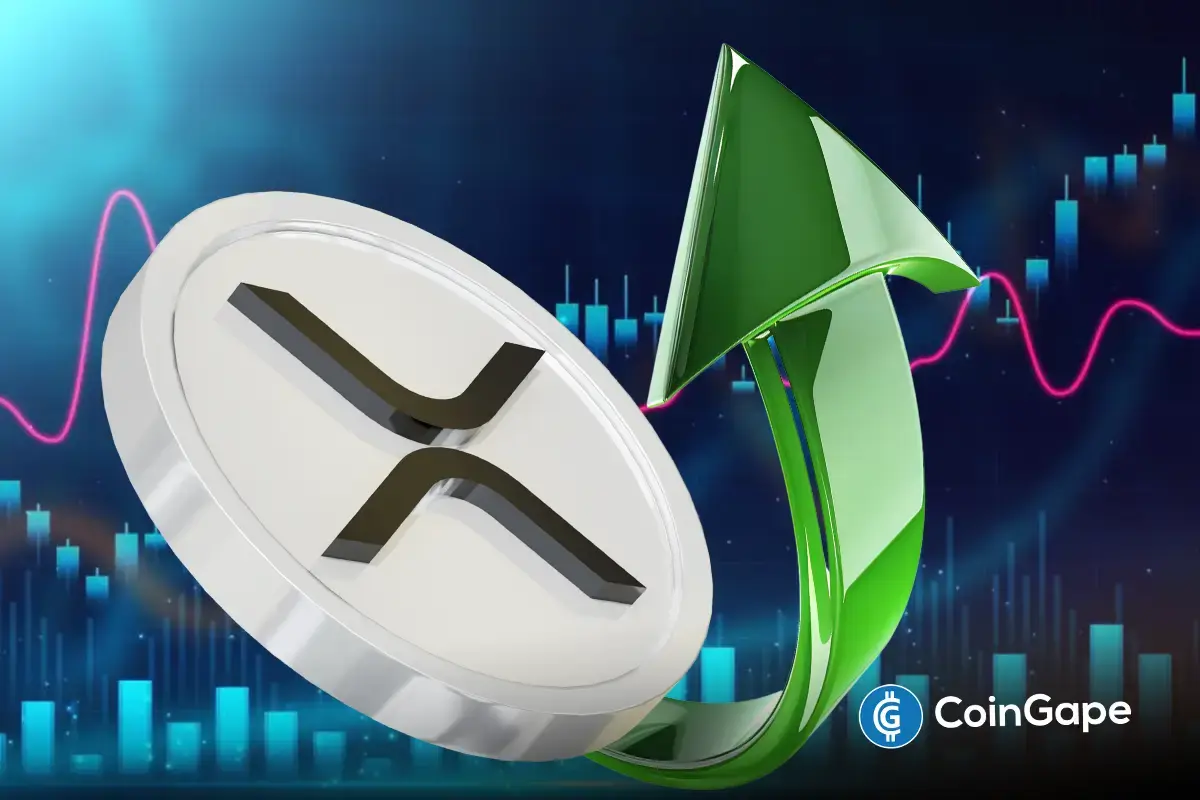
 Altcoin20 hours ago
Altcoin20 hours agoDid XRP Price Just Hit $21K? Live TV Display Error Goes Viral
-

 Altcoin14 hours ago
Altcoin14 hours agoPepe Coin Whale Sells 150 Billion Tokens, Price Fall Ahead?
-
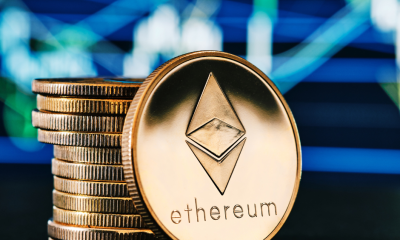
 Ethereum20 hours ago
Ethereum20 hours agoEthereum Breakdown, Analyst Eyes $1,130–$1,200 Price Target
-

 Market13 hours ago
Market13 hours agoXRP Falls 12% in a Week as Network Activity Declines
-

 Bitcoin20 hours ago
Bitcoin20 hours agoBitcoin Price Could Surge To $95,000 — But Analyst Sounds ‘Bull Trap’ Alarm
-

 Market19 hours ago
Market19 hours agoDark Web Criminals Are Selling Binance and Gemini User Data
-

 Market16 hours ago
Market16 hours agoVitalik Buterin Promotes Ethereum Layer 2 Roadmap
-
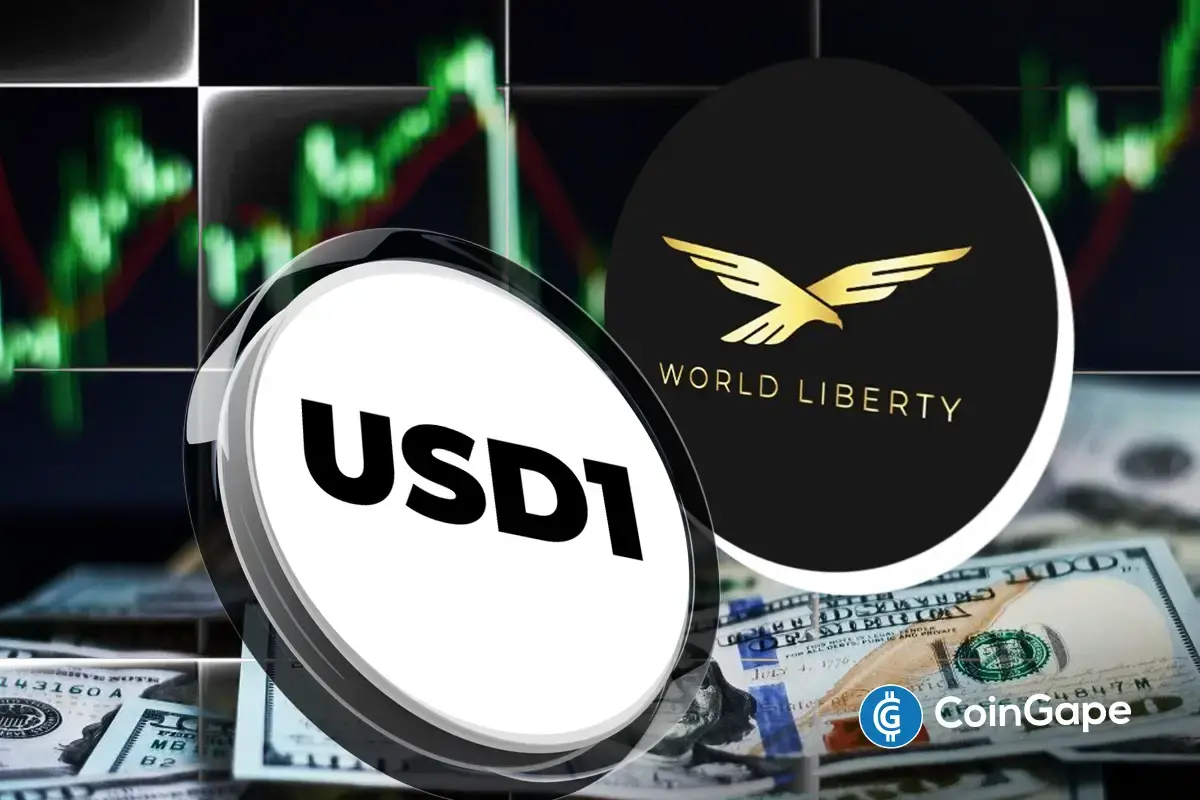
 Altcoin16 hours ago
Altcoin16 hours agoExpert Predicts Listing Date For WLFI’s USD1 Stablecoin, Here’s When


